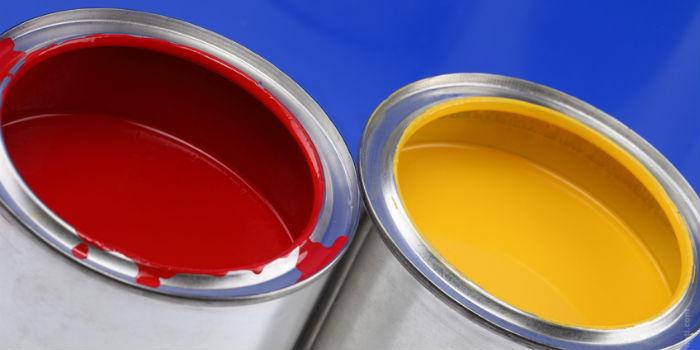 Characteristics of a new grinding resin, which in liquid form, is constituted as a new way to reduce volatile organic compounds (VOCs).
Characteristics of a new grinding resin, which in liquid form, is constituted as a new way to reduce volatile organic compounds (VOCs).
by Evonik
Thanks to its ingenious molecular structure, this grinding resin, unlike any other developed to date, gives paint and coating formulators the freedom to choose the raw materials used in industrial coatings.
Around the world, governments are reducing allowable volatile organic compound (VOC) emission limits. Different maximum permitted VOC limits have been in force in the European Union for several years (e.g. 420 g/L for finished renewal paints used in the automotive industry). Last year, China also enacted this limit for spray paints, following which taxes are now levied on paints containing VOCs in some parts of the country. Countries that have not yet defined maximum limits for VOCs will follow suit and laws are expected to become even stricter in the coming years in major markets such as the European Union and the United States.
This poses great challenges to paint and coating formulators. If they want to comply with legal requirements, they will have to drastically reduce the amount of solvent in their products and limit themselves only to certain raw materials.
Until now, most manufacturers producing raw materials for paints and coatings have focused on developing solutions for base layer VOC. However, the development of the new product referred to in this text focused on pigment concentrates, whose VOC content usually determines the final content of a painting.
Until now, the addition of a pigment concentrate to a base coating has coincided with an increase in the percentage by weight of VOC in the paint. Now that relationship has been reversed: adding the pigment concentrate effectively reduces the VOC content of the paint. A new liquid grinding resin makes this effect possible by reducing the VOC content in finished paint by an average of 20%, compared to standard solvent-containing industrial coatings on the market.
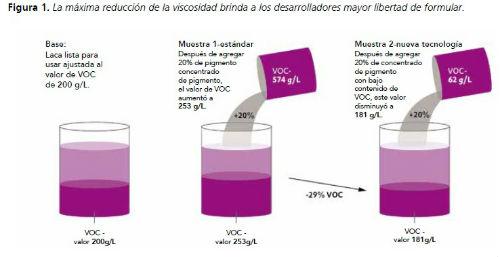
Figure 1. Maximum viscosity reduction gives developers greater freedom to formulate.
The new liquid grinding resin reduces viscosity in two ways: first, the resin is itself a liquid; secondly, it makes the manufactured pigment concentrate less viscous. For example, if the maximum VOC content is 310 g/L, then the viscosity of the standard product on the market (plus a standard additive) would be greater than 15,000 mPas, making it unusable. But the viscosity of liquid grinding resin combined with a standard additive is only 600 mPas at the same VOC level. The effect is even more evident with a VOC content of only 110 g/L; Even taking these extreme requirements into account, the viscosity of this liquid grinding resin combined with a properly adjusted additive is only 1,000 mPas.
The marked decrease in viscosity is possible because the resin has an exceptional affinity with the pigments and can better stabilize them to obtain an optimal pigment load. To achieve this, Evonik's developers formulated the resin in such a way as to counteract the tendency of pigment particles to flocular. To prevent van der Waals forces from causing flocculation, the space between the particles must be large enough that they can move easily.
Liquid grinding resin contains groups with an affinity with pigments, and it is this chemical structure that gives the resin a moisturizing effect – even without an additive – making it particularly effective in stabilizing materials. Reducing the interactions between the pigment particles decreases the viscosity of the pigment concentrate, which provides an exceptionally good stabilizing effect.
By moistening the pigment particles well—especially in combination with a suitable additive—liquid grinding resin produces a more intense color than others of its kind. On a test surface made of light grey polyurethane, (with a suitable additive) it was superior to the market standard at the same level of pigment – a difference that was evident even to the naked eye.
The low viscosity also decreases the amount of solvent required in the pigment concentrate, allowing formulators to increase the concentration of pigment particles. The result is a more intense color in the finished paint using the same amount of concentrate. If the desired viscosity is 2,000 mPas, the new grinding resin combined with an appropriate additive can have capacity for about 50% more pigment than similar competing products.
In addition, to achieve the same color development they had before, paint formulators now need less pigment concentrate. Therefore, formulators can do their part to make systems with high solids content more economical. Overall, the liquid form of the resin offers another advantage over the granulated forms that have been common so far: This grinding resin does not need to be dissolved in a solvent before being added. In other words, formulators can do without this step without having to find a replacement.
Color intensity
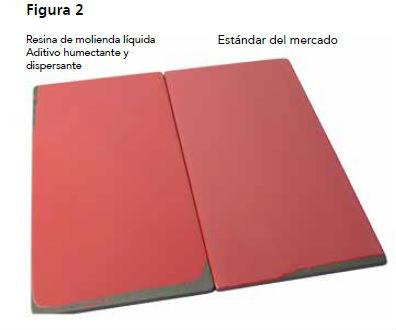
The hardness of the finished coating is not compromised by the liquid form of the resin: The developers were able to optimize the manufacturing process to the point where the low viscosity of the grinding resin has very little impact on the hardness of the paint. The team of specialists managed to adjust the glass transition temperature Tg, varying the composition of the monomers, in such a way that the impact of the first was minimal when it came to hardness, but still important in terms of VOC reduction. Approximately two years of intense development work were spent on the molecular structure of the new grinding resin.
In addition to this, however, the resin also meets all the requirements set for a grinding resin. Tests have shown that the product has minimal influence on coating properties such as gloss (DIN EN ISO 2813), weather resistance (DIN EN ISO 9227, DIN EN ISO 6270-2), adhesion (DIN EN ISO 2409), drying time ASTM D 5895), chemical resistance (DIN EN ISO 2812-4) and elasticity (DIN EN ISO 1520). The rubbing removal effect of paints and coatings based on this new grinding resin is much less than that of standard products on the market under the same conditions, regardless of whether polar or apolar solvents are used.
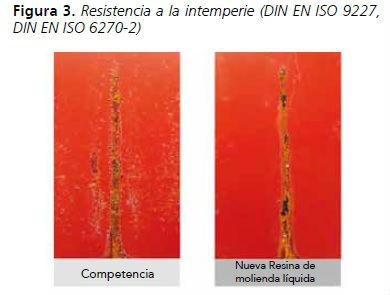
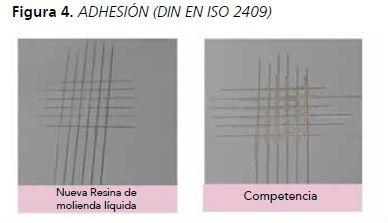
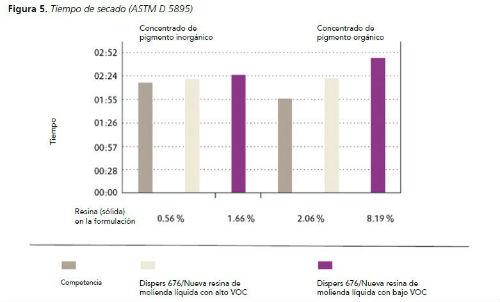
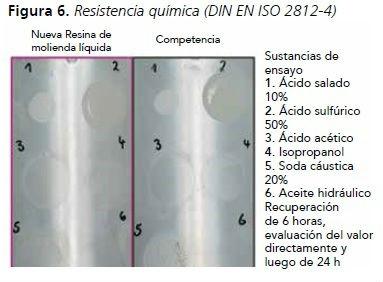
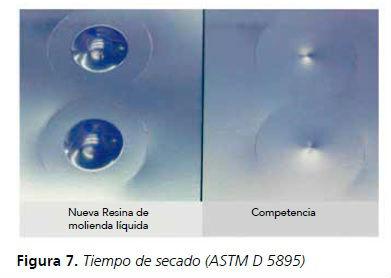
Liquid grinding resin is a ketone resin and, as such, tests have shown that it exhibits exceptional compatibility with all common binders and resins, including alkyd resins, polyethers, epoxy resins and nitrocellulose.
Although formulators prefer to use MPA as a solvent, studies have shown that it is not the best option in this case; given the reduction in viscosity, the developers recommend butyl acetate. When it comes to trying the best combination for their purposes, paint formulators have considerable freedom here as well.
The new grinding resin opens up a number of formulation options in addition to the wide selection of raw materials: The resulting paints and coatings are more suitable for aerosol application, for example. Due to its elasticity, liquid resin can also be used as a co-binder to bind intermediate layers to steel, galvanized steel or PVC. Liquid grinding resin can also be used to prolong the shelf life of the mixture.
The new grinding resin even offers advantages to formulators who do not yet need these properties. Due to the reduction of viscosity and the increase in color intensity, the inking process is more efficient and economical, this can also be used as a way to selectively improve efficiency. Without modifying the pigment concentration, formulators need much less resin per gram of pigment, allowing them to introduce a more economical solvent, without compromising the uniform color intensity or excellent friction values of the product.
Another advantage: The new opportunities provided by liquid grinding resin allow formulators to increase the concentration of pigment and also significantly reduce the amount of concentrate needed.
Evonik has also developed an additive specially designed to take full advantage of the viscosity benefits of the grinding resin: with the new moisturizing and dispersing additive a decrease in viscosity is achieved, thus reinforcing the positive effects of the resin. The developers did this by keeping the core of the molecule extremely compact and incorporating a large number of anchor groups, thanks to which an excellent wetting of the pigment was achieved. The stabilizing side chains were selected in such a way that the additive was effective on a wide range of polarities.
Conclusion
This new liquid grinding resin when used in combination with the specially developed dispersant additive, minimizes the VOC content of solvent-containing industrial paints and coatings. The result is an unprecedented product in today's market.
The new grinding resin even allows formulators to reconsider the use of binders that once had to be rejected (despite their other advantages) due to VOC thresholds. Due to the long product cycles of pigment concentrates and potentially stricter VOC limits, the new combination promises reliability in planning in the coming years.
In addition, this innovation will also give formulators more freedom to vary viscosities, pigment concentrations and formulations as a way to further optimize their existing systems.

























Leave your comment